- Home
- Peter F. Hamilton
Pandora's Star cs-2
Pandora's Star cs-2 Read online
Pandora's Star
( Commonwealth Saga - 2 )
Peter F. Hamilton
Pandora's Star
By
Peter Hamilton
PROLOGUE
Mars dominated space outside the Ulysses, a bloated dirty-ginger crescent of a planet that never quite made it as a world. Small, frigid, barren, airless, it was simply the solar system’s colder version of hell. Yet its glowing presence in the sky had dominated most of human history; first as a god to inspire generations of warriors, then as a goal to countless dreamers.
Now, for NASA Captain-Pilot Wilson Kime, it had become solid land. Two hundred kilometers beyond the landing craft’s narrow, curving windshield he could pick out the dark gash that was the Valles Marineris. As a boy he’d accessed the technofantasies of the Aries Underground group, entranced by how one day in an unspecified future, foaming water would once again race down that vast gully as raw human ingenuity unlocked the frozen ice trapped beneath the rusting landscape. Today, he would be the first to walk through those dusty craters he’d studied in a thousand satellite photos, trickle the legendary thin red sand through his gloved fingers. Today was glorious history in the making.
Wilson automatically started a deep feedback breathing exercise, calming his heart before the reality of what was about to happen could affect his metabolism. No way was he giving those goddamn desk medics back in Houston a chance to question his fitness to pilot the landing craft. Eight years he’d spent in the USAF, including two combat duties based in Japan for Operation Deliver Peace, followed by another nine years with NASA. All that buildup and anticipation: the sacrifices, his first wife and totally alienated kid; the eternal VR training at Houston, the press conferences, the mind-rotting PR tours of factories; he’d endured it all because it led to this one moment in this most sacred place.
Mars. At last!
“Initiating VKT ranging, cross match RL acquisition data,” he told the landing craft’s autopilot. The colored lines of the windshield’s holographic display began to change their geometrical patterns. He kept one eye on the timer: eight minutes. “Purging BGA system and vehicle interlink tunnel.” His left hand flicked the switches on the console, and tiny LEDs came on to confirm the switch cycle. Some actions NASA would never entrust to voice activation software. “Commencing BGA nonpropulsive vent. Awaiting prime ship sep sequence confirmation.”
“Roger that, Eagle II,” Nancy Kressmire’s voice said in his headset. “Telemetry analysis has you as fully functional. Prime ship power systems ready for disengagement.”
“Acknowledged,” he told the Ulysses ’s captain. Turquoise and emerald spiderwebs within the windshield fluttered elegantly, reporting the lander’s internal power status. Their sharp primary colors appeared somehow alien across the dull pallor of the wintry Martian landscape outside. “Switching to full internal power cells. I have seven greens for umbilical sep. Retracting inter-vehicle access tunnel.”
Alarmingly loud metallic clunks rang through the little cabin as the spaceplane’s airlock tunnel sank back into the fuselage. Even Wilson flinched at the intrusive sounds, and he knew the spaceplane’s mechanical layout better than its designers.
“Sir?” he asked. According to the NASA manual, once the lander’s airlock had retracted from the prime ship they were technically a fully independent vehicle; and Wilson wasn’t the ranking officer.
“The Eagle II is yours, Captain,” Commander Dylan Lewis said. “Take us down when you’re ready.”
Very conscious of the camera at the back of the cabin, Wilson said, “Thank you, sir. We are on-line for completed undocking in seven minutes.” He could sense the buzz in the five passengers riding behind him. All of them were the straightest of straight arrows; they had so much right stuff between them it could be bottled. Yet now the actual moment was here they were no more controlled than a bunch of school kids heading for their first beach party.
The autopilot ran through the remaining preflight prep sequence, with Wilson ordering and controlling the list; adhering faithfully to the man-in-the-loop tradition that dated all the way back to the Mercury Seven and their epic struggle for astronauts to be more than just spam in a can. Right on the seven-minute mark, the locking pins withdrew. He fired the RCS thrusters, pushing Eagle II gently away from the Ulysses . This time there was nothing he could do to stop his heart racing.
As they drew away, Ulysses became fully visible through the windshield. Wilson grinned happily at the sight of it. The interplanetary craft was the first of its kind: an ungainly collection of cylindrical modules, tanks, and girders arranged in a circular grid shape two hundred meters across. Its perimeter sprouted long jet-black solar power panels like plastic petals, all of them tracking the sun. Several of the crew habitation sections were painted in the stars and stripes, implausibly gaudy against the plain silver-white thermal foam that coated every centimeter of the superstructure. Right in the center of the vehicle, surrounded by a wide corrugated fan of silver thermal radiator panels, was the hexagonal chamber that housed the fusion generator that had made the ten-week flight time possible, constantly supplying power to the plasma rockets. It was the smallest fusion system ever built: a genuine made-in-America, cutting-edge chunk of technology. Europe was still building its first pair of commercial fusion reactors on the ground, while the USA had already commissioned five such units, with another fifteen being built. And the Europeans certainly hadn’t got anything equivalent to the sophisticated Ulysses generator.
Damnit, we can still get some things right, Wilson thought proudly as the shining conglomeration of space hardware diminished into the eternal night. It would be another decade until the FESA could mount a Mars mission, by which time NASA planned on having a self-sustaining base on the icy sands of Arabia Terra. Hopefully, by then, the agency would also be flying asteroid-capture missions and even a Jovian expedition as well. I’m not too old to be a part of those, they’ll need experienced commanders.
His mind underwent just the tiniest tweak of envy at the prospect of what would come in the midterm future, events and miracles whose timetable and budget allocations meant they might just elude him. The Europeans can afford to wait, though. While thanks to the dominant influence of the Religious Right over the last few administrations, the U.S. had halted all genetic work centered around stem cells, the Federal government in Brussels had poured money into biogenic research, with spectacular results. Now that the early bugs had been ironed out of the hugely expensive procedure, they’d begun to rejuvenate people. The first man to receive the treatment, Jeff Baker, had died in a climax of global publicity; but in the following seven years there had been eighteen successes.
Space and Life. Those separate interests spoke volumes about the way the cultures of Earth’s two major Western power groups had diverged over the past three decades.
Now Wilson’s fellow Americans were beginning to reevaluate their attitude to genetic engineering. Already there were urban myths of Caribbean and Asian clinics offering the rejuvenation service to multibillionaires. And Federal Europe was once again attempting to narrow the American lead in space, desperate to prove to the world that it excelled in every field. Given the fractious political state currently afflicting the planet, Wilson rather welcomed the idea of the two blocs drawing closer together once more—that was, after Americans had landed on Mars.
“First de-orbit burn in three minutes,” the Eagle II’s autopilot said.
“Standing by,” Wilson told it. He automatically checked the fuel tank pressures, and followed that up with main engine ignition procedures.
Three hypergolic fuel rockets at the back of the little spaceplane fired for a hundred seconds, pushing their orbit into an atmosphere-int
ercept trajectory. The subsequent airbrake maneuver lasted for over ninety minutes, with the scant Martian atmosphere pushing against the craft’s swept delta wings, killing its velocity. For the final fifteen minutes, Wilson could see the faintest of pink glows coming from the Eagle II’s blunt nose. It was the only evidence of the violence being done to the fuselage by high-velocity gas molecule impacts. The ride was incredibly smooth, with gravity slowly building as they sank toward the crater-rumpled landscape of Arabia Terra.
At six kilometers altitude, Wilson activated their profile dynamic wings. They began to expand, spreading out wide to generate as much lift as possible from the thin, frigid air. At full stretch they measured a hundred meters from tip to tip, enough to allow Eagle II to glide if necessary. Then their turbine fired up, gently thrusting them forward, keeping speed constant at two hundred fifty kilometers an hour. The westernmost edge of the massive Schiaparelli Crater slid into sight away in the distance, rolling walls rising up out of the rumpled ground like a weather worn mountain range.
“Visual acquisition of landing site,” Wilson reported. His systems schematics were tracing green and blue sine waves across the view. Ground radar began to overlay a three-dimensional grid of spikes and gullies that almost matched what he could see.
“Eagle II, midpoint systems review confirms you are go for landing,” said Mission Control. “Good luck, guys. You’ve got quite an audience back here.”
“Thank you, Mission Control,” Commander Lewis said formally. “We are eager for the touchdown. Hoping Wilson can give us a smooth one.” It would be another four minutes before anyone back on Earth heard his words. By then they should be down.
“Contact with cargo landers beacon,” Wilson reported. “Range thirty-eight kilometers.” He squinted through the windshield as the autopilot printed up a red line-of-sight bracket within the glass. The crater rim grew steadily larger. “Ah, I’ve got them.” Two dusty gray specks sitting on a broad patch of flat landscape.
For the last stage, Eagle II flew a slow circle around the pair of robot cargo landers. They were simple squat cones that the Ulysses had sent down two days earlier, loaded with tons of equipment, including a small prefab ground base. Getting them unloaded and the projected exploration campus up and running was the principal task awaiting the crew of the Eagle II.
“Groundscan confirms area one viability,” Wilson said. He was almost disappointed at the radar picture. When Neil Armstrong and Buzz Aldrin were landing on the moon, they had to hurriedly take manual control of their Lunar Module and fly it to safety when the designated landing site turned out to be strewn with boulders. This time, eighty-one years later, satellite imagery and orbital radar mapping had eliminated such uncertainty from the flight profile.
He brought the Eagle II around on its preplotted approach path, engaging the autopilot. “Landing gear extended and locked. VM engines pressurized and ready. Profile dynamic wings in reshape mode. Ground speed approaching one hundred kilometers per hour. Descent rate nominal. We’re on the wire, people.”
“Good work, Wilson,” Commander Lewis said. “Let’s bump struts, here, huh?”
“You got it, sir.”
The landing rockets fired, and Eagle II began to sink smoothly out of the light pink sky. A hundred meters up, and Wilson couldn’t stand it. His fingers flicked four switches, taking the autopilot off-line. Red LEDs glared accusingly at him from the console. He ignored them, bringing the little spaceplane down manually. Easier than any simulation. Dust swirled outside the windshield, thick and cloying as the rocket jets scoured the surface of Mars. Radar gave him the final approach vectors, there was nothing to see visually. They settled without a wobble. The sound of the rockets died away. External light began to brighten as the agitated dust flurries dissipated.
“Houston, the Eagle II has landed,” Wilson said. The words had to be forced out, his throat was so tensed up with pride and exhilaration. He could hear that beautiful phrase echo along history, past and future. And I made it happen, not some goddamn machine.
A wave of jubilant shouts and cheering broke out in the cabin behind him. He wiped an errant drop of moisture from his eye with the back of one hand. Then he was suddenly involved with systems supervision, reengaging the autopilot. External instrumentation confirmed they were down and stable. The spaceplane had to be put into surface standby mode, supplying power and environmental services to the cabin, keeping the rocket engines warm so that takeoff wouldn’t be a problem, monitoring the fuel tank status. A long, boring list of procedures that he worked through with flawless diligence.
Only then did the six of them begin to suit up. Given the cabin’s chronic lack of space, it was a cramped, difficult process, with everyone jostling each other. When Wilson was almost ready, Dylan Lewis handed him his helmet.
“Thanks.”
The Commander didn’t say anything, just gave Wilson a look. As reprimands went, it didn’t get much worse than that.
To hell with you, Wilson retorted silently. We’re the important thing, people coming to Mars is what matters, not the machines we come in. I couldn’t allow a software program to land us.
Wilson stood in line as the Commander went into the small airlock at the back of the cabin. Third, I get to be third. Back on Earth they’d only ever remember that Dylan Lewis was first. Wilson didn’t care. Third.
The tiny display grid inside Wilson’s helmet relayed an image from the external camera set just above the airlock door. It showed a slim aluminum ladder stretching down to the Martian sand. Commander Lewis backed out of the open airlock, his foot moving slowly and carefully onto the top rung. Wilson wanted to shout: For God’s sake get a move on! The suit’s medical telemetry told him his skin was flushed and perspiring. He tried to do his deep feedback breathing exercise thing, but it didn’t seem to work.
Commander Lewis was taking the ladder rungs one at a time. Wilson and the others in the cabin held their breaths; he could feel a couple of billion people doing the same thing back on the old home planet.
“I take this step for all of humanity, so that we may walk together as one people along the road to the stars.”
Wilson winced at the words. Lewis sounded incredibly sincere. Then someone sniggered, actually sniggered out loud; he could hear it quite plainly over the general communications band. Mission Control would go ballistic over that.
Then he forgot it all as Lewis took his step onto the surface, his foot sinking slightly into the red sand of Mars to make a firm imprint.
“We did it,” Wilson whispered to himself. “We did it, we’re here.” Another outbreak of cheering went around the cabin. Congratulatory calls flooded down from Ulysses . Jane Orchiston was already clambering into the airlock. Wilson didn’t even begrudge her that; political correctness wouldn’t allow it any other way. And NASA was ever mindful of pleasing as many people as possible.
Commander Lewis was busy taking a high-resolution photo of his historic footprint. A requirement that had been in the NASA manual for the last eighty-one years, ever since Apollo 11 got back home to find that embarrassing omission.
Lieutenant Commander Orchiston was going down the ladder—a lot faster than Commander Lewis. Wilson stepped into the airlock. He couldn’t even remember the time the little chamber took to cycle; it never existed in his personal awareness. Then it was him backing out onto the ladder. Him checking his feet were secure on the rungs before placing all his—reduced—weight on them. Him hanging poised on the bottom rung. “I wish you could see this, Dad.” He put his foot down, and he was standing on Mars.
Wilson moved away from the ladder, cautious in the low gravity. Heart pounding away in his ears. Breathing loud in the helmet. Hiss of helmet air fans ever-present. Ghostly suit graphic symbols flickered annoyingly across his full field of vision. Other people talked directly into his ears. He stopped and turned full circle. Mars! Dirty rocks littering the ground. Sharp horizon. Small glaring sun. He searched around until he found the star that was E
arth. Brought up a hand and waved solemnly at it.
“Want to give me a hand with this?” Commander Lewis asked. He was holding the flagpole, stars and stripes still furled tightly around the top.
“Yes, sir.”
Jeff Silverman, the geophysicist, was already on the ladder. Wilson walked over to help the Commander with the flagpole. He gave the Eagle II a critical assessment glance on his way. There were some scorch marks along the fuselage, trailing away from the wing roots, very faint, though. Other than that: nothing. It was in good shape.
The Commander was attempting to open out the little tripod on the base of the flagpole. His heavy gloved hands making the operation difficult. Wilson put out his own hand to steady the pole.
“Yo, dudes, how’s it hanging? You need any help there?” The question was followed by a snigger, the same one he’d heard earlier.
Wilson knew the voice of everybody on the mission. Spend that long together with thirty-eight people in such a confined space as the Ulysses and vocal recognition became perfect. Whoever spoke wasn’t on the crew. Yet somehow he knew it was real-time, not some pirate hack from Earth.
Commander Lewis had frozen, the flagpole tripod still not fully deployed. “Who said that?”
“That’d be me, my man. Nigel Sheldon, at your service. Specially if you need to get home in like a hurry.” That snigger again. Then someone else saying: “Oh, man, don’t do that, you’re going to so piss them off.”
“Who is this?” Lewis demanded.
Wilson was already moving, glide walking as fast as was safe in the low gravity, making for the rear of the Eagle II. He knew they were close, and he could see everything on this side of the spaceplane. As soon as he was past the bell-shaped rocket nozzles he forced himself to a halt. Someone else was standing there, arm held high in an almost apologetic wave. Someone in what looked like a homemade space suit. Which was an insane interpretation, but it was definitely a pressure garment of some type, possibly modified from deep-sea gear. The outer fabric was made up from flat ridges of dull brown rubber, in pronounced contrast to Wilson’s snow-white ten-million-dollar Martian Environment Excursion suit. The helmet was the nineteen fifties classic goldfish bowl, a clear glass bubble showing the head of a young man with a scraggly beard and long oily blond hair tied back into a pigtail. No radiation protection, Wilson thought inanely. There was no backpack either, no portable life-support module. Instead, a bundle of pressure hoses snaked away from the youth’s waist to a…

 A Night Without Stars
A Night Without Stars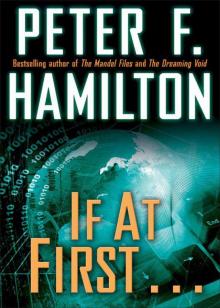 If at First . . .
If at First . . . The Neutronium Alchemist
The Neutronium Alchemist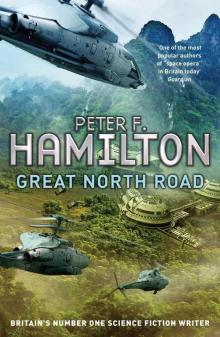 Great North Road
Great North Road Misspent Youth
Misspent Youth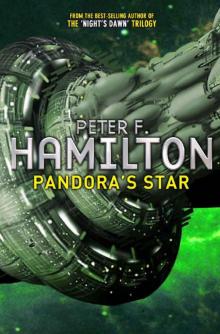 Pandora's Star
Pandora's Star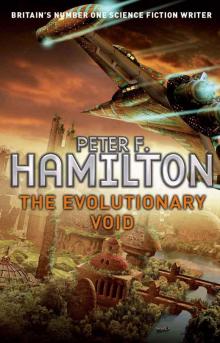 The Evolutionary Void
The Evolutionary Void The Dreaming Void
The Dreaming Void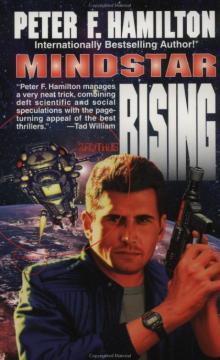 Mindstar Rising
Mindstar Rising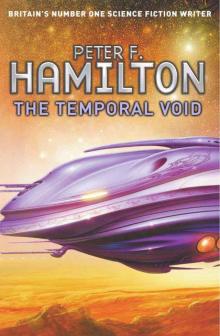 The Temporal Void
The Temporal Void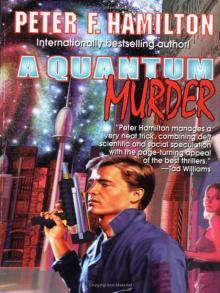 A Quantum Murder
A Quantum Murder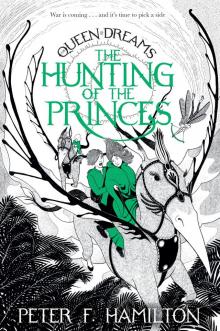 The Hunting of the Princes
The Hunting of the Princes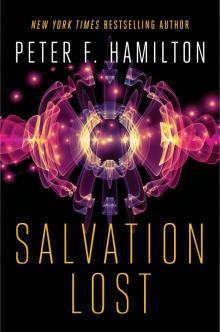 Salvation Lost
Salvation Lost The Dreaming
The Dreaming Salvation
Salvation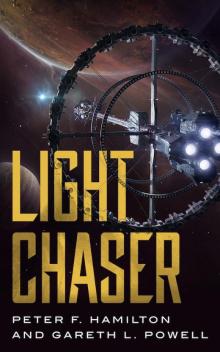 Light Chaser
Light Chaser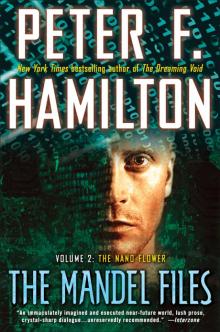 The Mandel Files, Volume 2: The Nano Flower
The Mandel Files, Volume 2: The Nano Flower![The Saints of Salvation [British Ed.] Read online](http://i1.bookreadfree.com/22/the_saints_of_salvation_british_ed__preview.jpg) The Saints of Salvation [British Ed.]
The Saints of Salvation [British Ed.]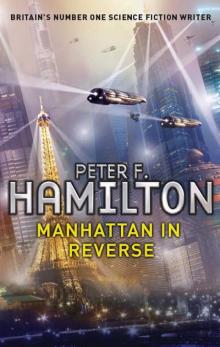 Manhattan in Reverse
Manhattan in Reverse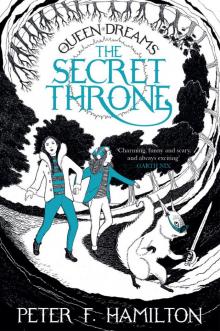 The Secret Throne
The Secret Throne A Window Into Time
A Window Into Time A Second Chance at Eden
A Second Chance at Eden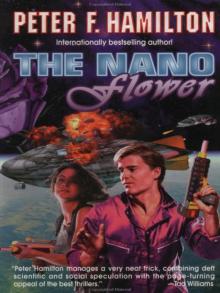 The Nano Flower
The Nano Flower The Confederation Handbook
The Confederation Handbook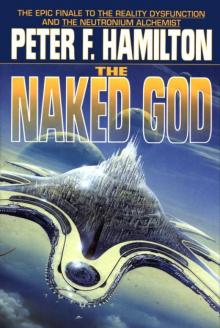 The Naked God
The Naked God The Saints of Salvation
The Saints of Salvation The Void Trilogy 3-Book Bundle
The Void Trilogy 3-Book Bundle The Abyss Beyond Dreams
The Abyss Beyond Dreams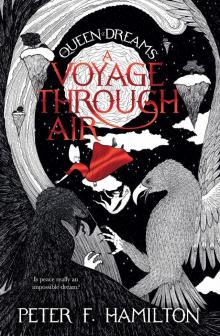 A Voyage Through Air
A Voyage Through Air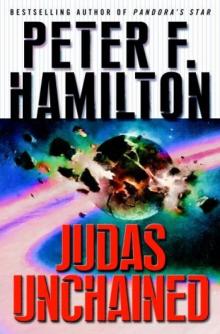 Judas Unchained
Judas Unchained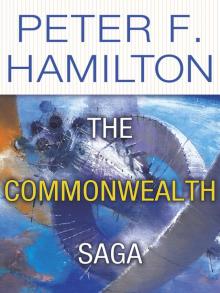 The Commonwealth Saga 2-Book Bundle
The Commonwealth Saga 2-Book Bundle The Naked God - Flight nd-5
The Naked God - Flight nd-5 Night Without Stars (Chronicle of the Fallers Book 2)
Night Without Stars (Chronicle of the Fallers Book 2)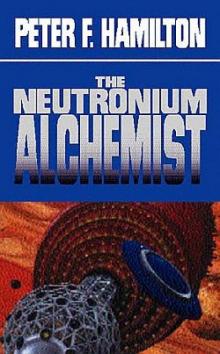 Neutronium Alchemist - Conflict nd-4
Neutronium Alchemist - Conflict nd-4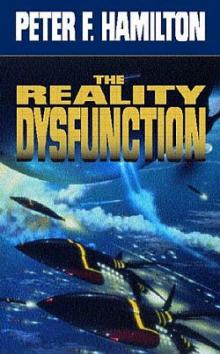 Reality Dysfunction - Expansion nd-2
Reality Dysfunction - Expansion nd-2 Now We Are Ten: Celebrating the First Ten Years of NewCon Press
Now We Are Ten: Celebrating the First Ten Years of NewCon Press Neutronium Alchemist - Consolidation nd-3
Neutronium Alchemist - Consolidation nd-3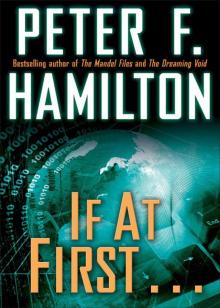 If at First . . . (Short Story)
If at First . . . (Short Story) A Second Chance at Eden nd-7
A Second Chance at Eden nd-7 Judas Unchained cs-2
Judas Unchained cs-2 The Mandel Files, Volume 1
The Mandel Files, Volume 1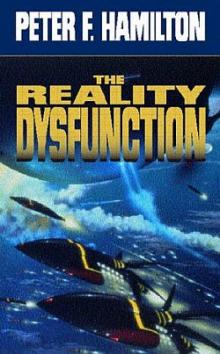 Reality Dysfunction — Emergence nd-1
Reality Dysfunction — Emergence nd-1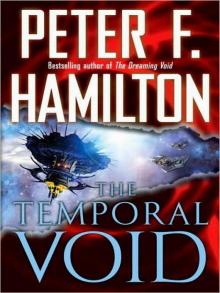 The Temporal Void (ARC)
The Temporal Void (ARC) The Mandel Files
The Mandel Files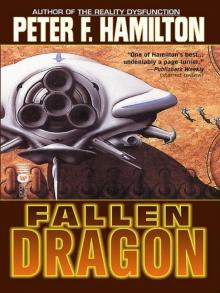 Fallen Fragon
Fallen Fragon Misspent Youth (commonwealth saga)
Misspent Youth (commonwealth saga)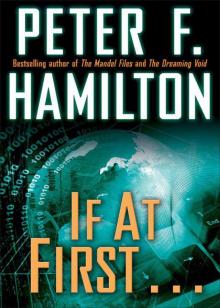 If at First...
If at First... Best of British Science Fiction 2016
Best of British Science Fiction 2016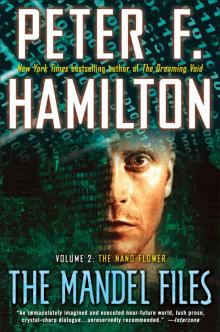 The Mandel Files, Volume 2
The Mandel Files, Volume 2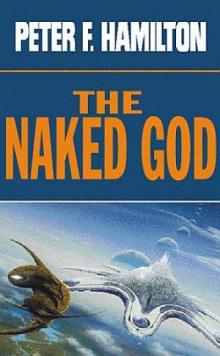 The Naked God - Faith nd-6
The Naked God - Faith nd-6 The Night's Dawn Trilogy
The Night's Dawn Trilogy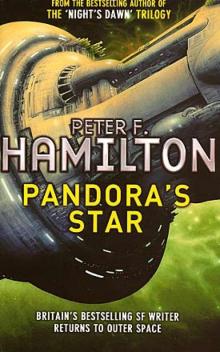 Pandora's Star cs-2
Pandora's Star cs-2 A Window into Time (Novella)
A Window into Time (Novella)